You can't recharge regular alkaline batteries safely, as they're designed for single use and can leak or even explode if charged improperly. Instead, opt for rechargeable batteries like NiMH, which can last through thousands of cycles. To prolong battery life, store them in a cool, dry place, avoid overcharging, and regularly inspect for signs of wear, like corrosion or reduced performance. Using smart chargers that monitor voltage helps, too. Keep an eye on the charging duration—typically 2 to 6 hours. For more tips on managing and recycling batteries, there's plenty more to explore.
Key Takeaways
- Regular alkaline batteries are non-rechargeable; charging them can cause leakage or explosion, so only recharge batteries labeled as rechargeable alkaline.
- To prolong the life of rechargeable batteries, use specialized chargers that prevent overheating and monitor voltage during the charging process.
- Avoid overnight charging; it can lead to reduced battery life and safety hazards, instead, monitor charging durations of 2 to 6 hours.
- Regularly inspect batteries for signs of wear, such as corrosion or voltage drops, to identify issues early and prolong their lifespan.
- Engage with the community and share knowledge about battery management practices to enhance understanding and promote sustainable usage.
Understanding Battery Types
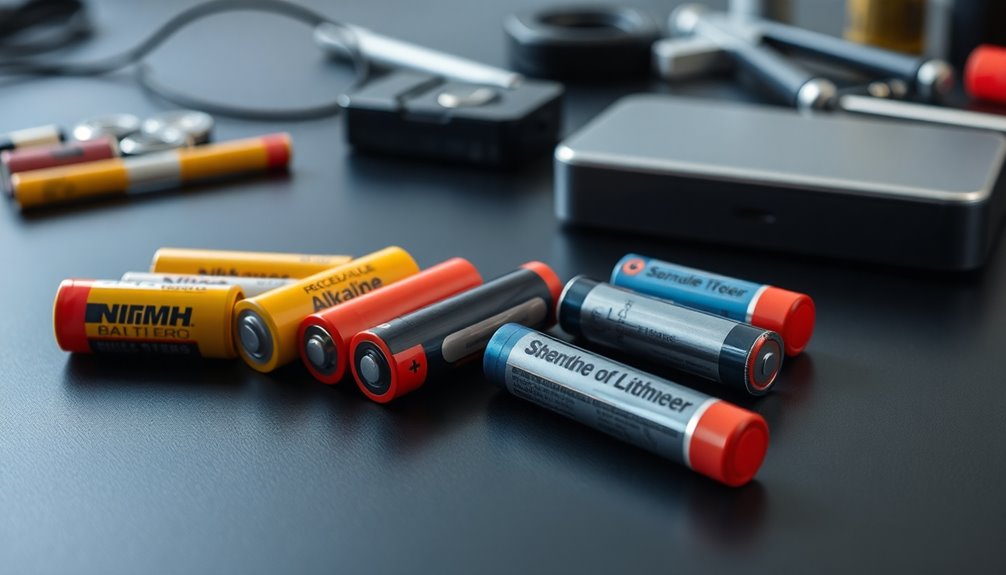
When you're choosing batteries for your devices, understanding the different types available is essential. The most common battery types are alkaline batteries, Nickel Metal Hydride (NiMH), and Lithium-Ion (Li-ion).
Alkaline batteries are typically non-rechargeable and can leak or explode if improperly charged. On the other hand, NiMH batteries are designed for recharging and can last through thousands of cycles, making them ideal for household devices. They balance capacity and rechargeability better than alkaline batteries, which lose performance after limited recharges.
Lithium-Ion batteries, though not the focus here, provide high energy density and low self-discharge rates for modern electronics.
Knowing these battery types helps you make informed decisions and guarantees peak device performance.
Charging Regular Batteries
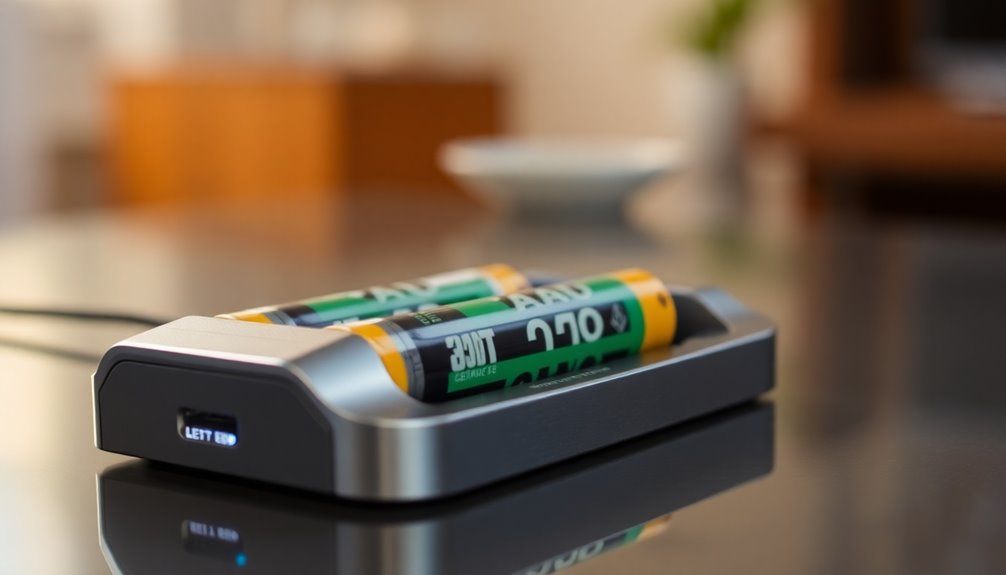
When it comes to charging regular batteries, you need to understand both safety guidelines and proper maintenance.
It's crucial to use the right charger and monitor the batteries during the charging process to avoid hazards.
Battery Types Overview
While many people are familiar with rechargeable batteries, it's important to understand that regular alkaline batteries can also be recharged under certain conditions.
You can recharge these batteries up to 15 times, but their performance varies considerably based on the power demands of your device. High-drain devices may only allow for 1-4 recharges.
To charge alkaline batteries safely, use specific chargers designed for them and avoid charging damaged batteries to prevent leaks.
Typically, alkaline batteries work well with older technology requiring a 1.5V output, while rechargeable NiMH batteries excel in high-drain applications.
Charging Safety Guidelines
Although recharging regular alkaline batteries can be tempting, it's crucial to follow specific safety guidelines to prevent accidents.
First, only charge batteries specifically labeled as rechargeable alkaline, as regular ones aren't designed for this purpose and can leak or explode.
Use a specialized charger that monitors voltage and prevents overheating; this can help prolong the life of the batteries and allow recharging up to 15 times.
Always inspect each battery for damage or corrosion before charging, as compromised batteries can create hazards.
During charging, keep an eye on them, as the process typically takes 2 to 6 hours.
Finally, avoid mixing brands or types in the same charger to minimize risks and guarantee safe charging.
Maintenance and Care Tips
To keep your recharged alkaline batteries performing their best, regular maintenance and care are essential. Remember, you can extend the life of your rechargeable batteries by following these tips:
| Tip | Description | Benefit |
|---|---|---|
| Recharge Before Use | Charge batteries shortly before use. | Guarantees peak voltage. |
| Clean Terminals | Keep battery terminals clean and corrosion-free. | Enhances performance. |
| Check for Leakage | Inspect for signs of leakage regularly. | Prevents device damage. |
Signs of Battery Wear

Battery wear can sneak up on you, often revealing itself through several telltale signs that indicate it's time for a replacement.
One clear sign of deterioration is reduced performance; your devices may start to show intermittent functionality or fail altogether. You might also notice corrosion on battery terminals, which appears as white or greenish residue and can hinder performance.
If you see a significant drop in voltage output, especially below 1.5V for alkaline batteries, it's another warning sign. Physical changes like swelling or leakage indicate severe battery wear and pose safety risks.
Regularly monitoring your rechargeable batteries can help identify these issues early, allowing you to prolong their lifespan and avoid over-discharge.
Safe Charging Practices
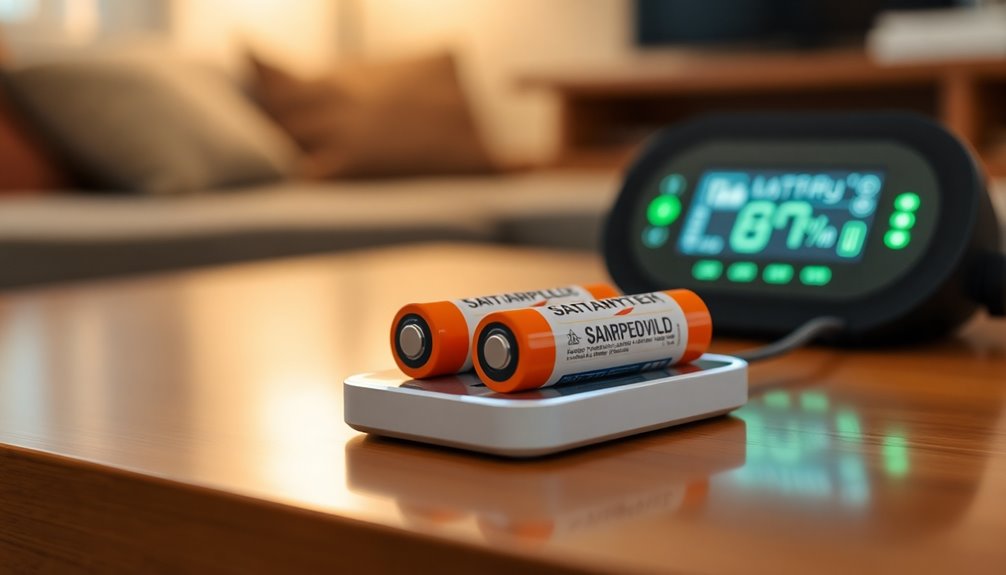
When charging your batteries, keep a close eye on the duration to prevent overcharging, which can lead to overheating.
It's also essential to regularly clean the battery terminals, as dirt and corrosion can affect performance and safety.
Charging Duration Monitoring
Although charging your batteries might seem straightforward, keeping a close eye on the duration is essential for safety and efficiency. Charging durations for alkaline batteries usually range from 2 to 6 hours, so you need to monitor them closely to prevent overheating and leakage.
It's also important not to leave most rechargeable batteries charging overnight, as this can lead to overcharging, reducing battery life and posing safety hazards. Using a smart charger is a smart move; these devices automatically monitor voltage and stop charging once the batteries are fully charged.
Regularly check for signs of overheating during the process, as excessive heat can expedite leakage and damage the battery. Always follow the manufacturer's guidelines for peak performance.
Clean Battery Terminals Regularly
Corroded battery terminals can lead to frustrating performance issues and even device failure. To maintain peak battery performance, you should regularly clean battery terminals. Use a dry cloth to wipe away moisture and residue, preventing corrosion. Here's a quick reference table for cleaning methods:
| Method | Material Used | Effectiveness |
|---|---|---|
| Dry Cloth | Microfiber cloth | Good for dust |
| Vinegar/Cotton Swab | Vinegar | Neutralizes corrosion |
| Baking Soda/Cotton Swab | Baking soda | Removes stubborn buildup |
Make it a habit to check terminals before storing batteries for extended periods. Clean battery terminals not only enhance performance but also prolong battery life by reducing resistance and ensuring better voltage output.
Tips for Battery Maintenance
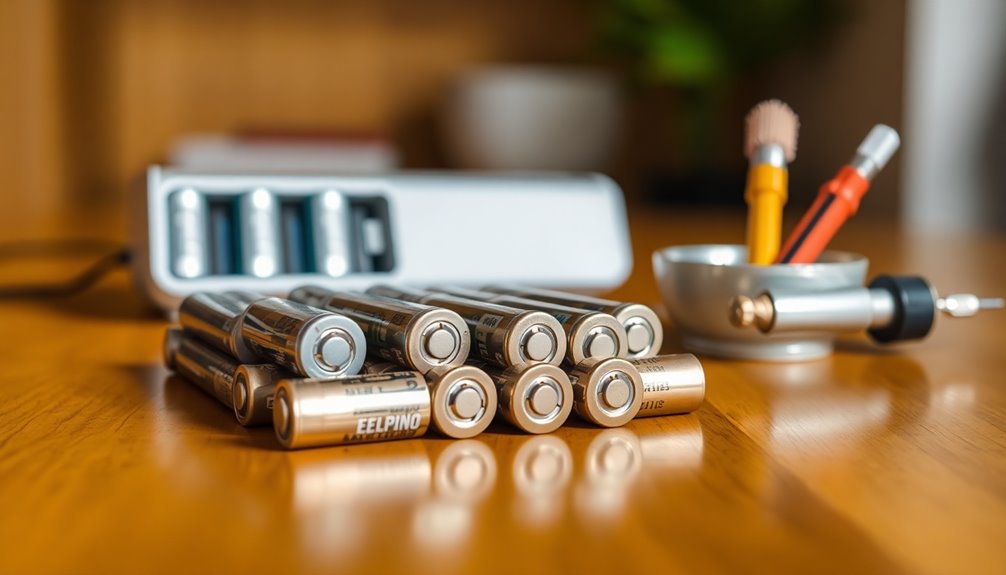
To guarantee your batteries perform at their best, regular maintenance is key. Start by cleaning the battery terminals with a dry cloth to prevent corrosion, which can hinder functionality.
When storing unused rechargeable batteries, keep them in a cool, dry environment and recharge them every 3-6 months to maintain voltage and avoid damage. It's important to avoid leaving rechargeable batteries to charge overnight, as this can reduce their lifespan.
Regularly monitor your batteries during long-term storage to catch issues like leakage or depletion early. Finally, always use manufacturer-recommended chargers for compatibility and safety; improper charging can lead to overheating, leakage, or reduced efficiency.
Recycling and Sustainability
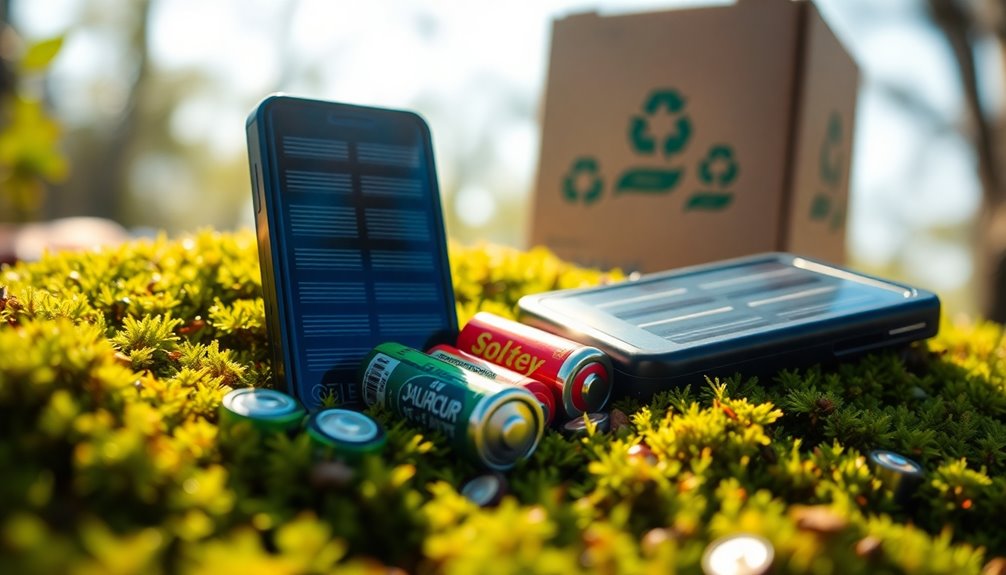
Maintaining your batteries isn't just about performance; it's also about sustainability. By recycling and using rechargeable batteries, you can greatly reduce waste and environmental impact.
Consider these key points:
- Rechargeable batteries, like NiMH, can be used thousands of times, minimizing waste.
- Alkaline batteries aren't designed for recharging and can leak harmful substances if not disposed of properly.
- Recycling programs help recover valuable materials and lessen ecological degradation from mining.
- Proper disposal through designated recycling facilities prevents toxic materials from harming the environment.
Engaging in these sustainable practices not only benefits you but also contributes to a healthier planet.
Community Insights and Resources
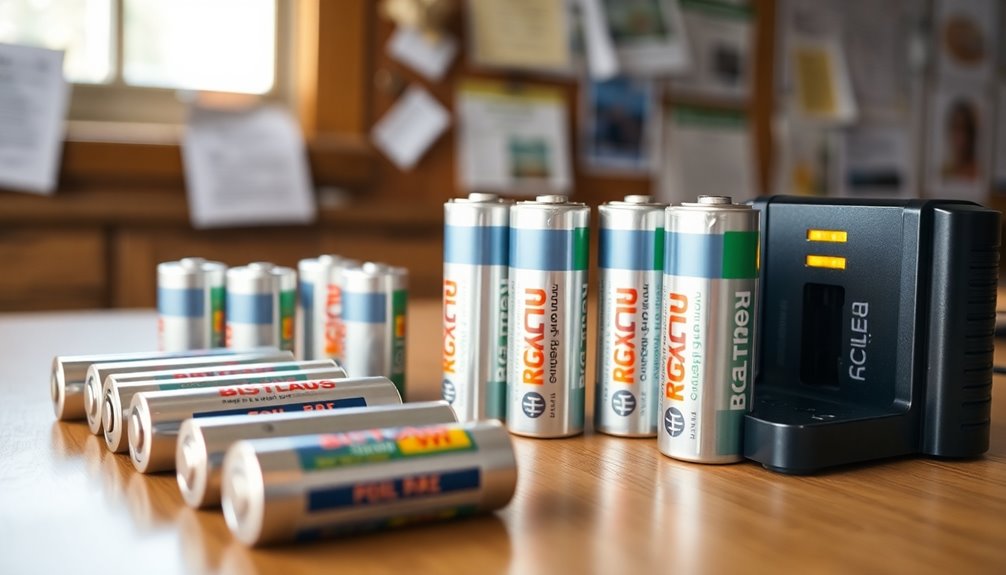
As you immerse yourself in the world of battery care, connecting with community insights can be invaluable. Platforms like Linus Tech Tips provide a wealth of shared experiences and effective practices for managing batteries, including recharging disposable batteries.
You can post questions and receive helpful responses, fostering collaboration on battery-related issues. Engaging with fellow users allows you to discover tips on improving the life of your rechargeable batteries while staying informed about the latest trends and innovations.
Recent discussions also cover tech reviews and product recommendations, enhancing your decision-making skills. By tapping into these community resources, you not only gain knowledge but also contribute to a collective understanding of best practices for battery care. Moreover, hearing assessments can play a crucial role in understanding how environmental factors, such as loud sounds, impact battery-operated hearing aids, emphasizing the importance of regular evaluations.
Future of Battery Technology

While the landscape of battery technology continues to evolve, innovations such as solid-state batteries are paving the way for a safer and more efficient future.
These advancements promise to revolutionize the way we think about rechargeable Li-ion batteries. Here are some exciting developments on the horizon:
- Higher energy densities with solid-state batteries
- Enhanced battery recycling technologies for sustainability
- Reduced charging times, potentially under five minutes
- Alternative materials like sodium-ion and magnesium-ion
With these innovations, you can expect batteries that aren't only more powerful but also environmentally friendly.
The integration of artificial intelligence in battery management systems will optimize performance and extend lifespan, ensuring your devices run efficiently for longer periods.
Frequently Asked Questions
Is It OK to Recharge a Regular Battery?
It's not safe to recharge regular batteries.
They're not designed for that, and trying to do so can lead to leakage or even explosions.
While you might get a few extra uses out of them, their performance drops considerably after just a few recharges.
Instead, consider using rechargeable batteries, which can handle multiple charges and save you money in the long run, plus they're better for the environment.
How Can I Extend the Lifespan of My Battery?
To extend your battery's lifespan, store it in a cool, dry place. High temperatures can drain its power faster.
Recharge NiMH batteries every 3-6 months to keep their voltage up. Clean the terminals regularly to prevent corrosion, which can damage performance.
Avoid mixing old and new batteries in devices; it can cause issues. Finally, charge your batteries shortly before you need to use them for maximum efficiency.
How Do You Charge a Battery to Prolong Life?
Charging a battery properly can feel intimidating, but it doesn't have to be. To prolong its life, recharge it regularly—ideally every 3-6 months.
Always use a charger designed specifically for that battery type. Keep an eye on the charging process; unplug it once it's fully charged to avoid overcharging.
Store it in a cool, dry place, and clean the terminals often to prevent corrosion. With these steps, you'll guarantee your battery lasts longer.
What Happens When You Recharge a Non-Rechargeable Battery?
When you try to recharge a non-rechargeable battery, you're risking serious damage.
These batteries aren't built for charging, which can lead to overheating, leakage, or even explosions. You might think a slow charge could work, but it's still dangerous and often ineffective.
If you go ahead, monitor the temperature closely; any swelling or excessive heat is a sign you should stop immediately.
Conclusion
In your quest to prolong battery life, you might find it surprising how simple habits can lead to significant savings and sustainability. By understanding battery types and adopting safe charging practices, you're not just extending their life; you're also reducing waste. Just as you charge your devices, you can charge your commitment to the planet. Coincidentally, the more you care for your batteries, the more they care for you—keeping your gadgets running smoothly and your conscience clear.










